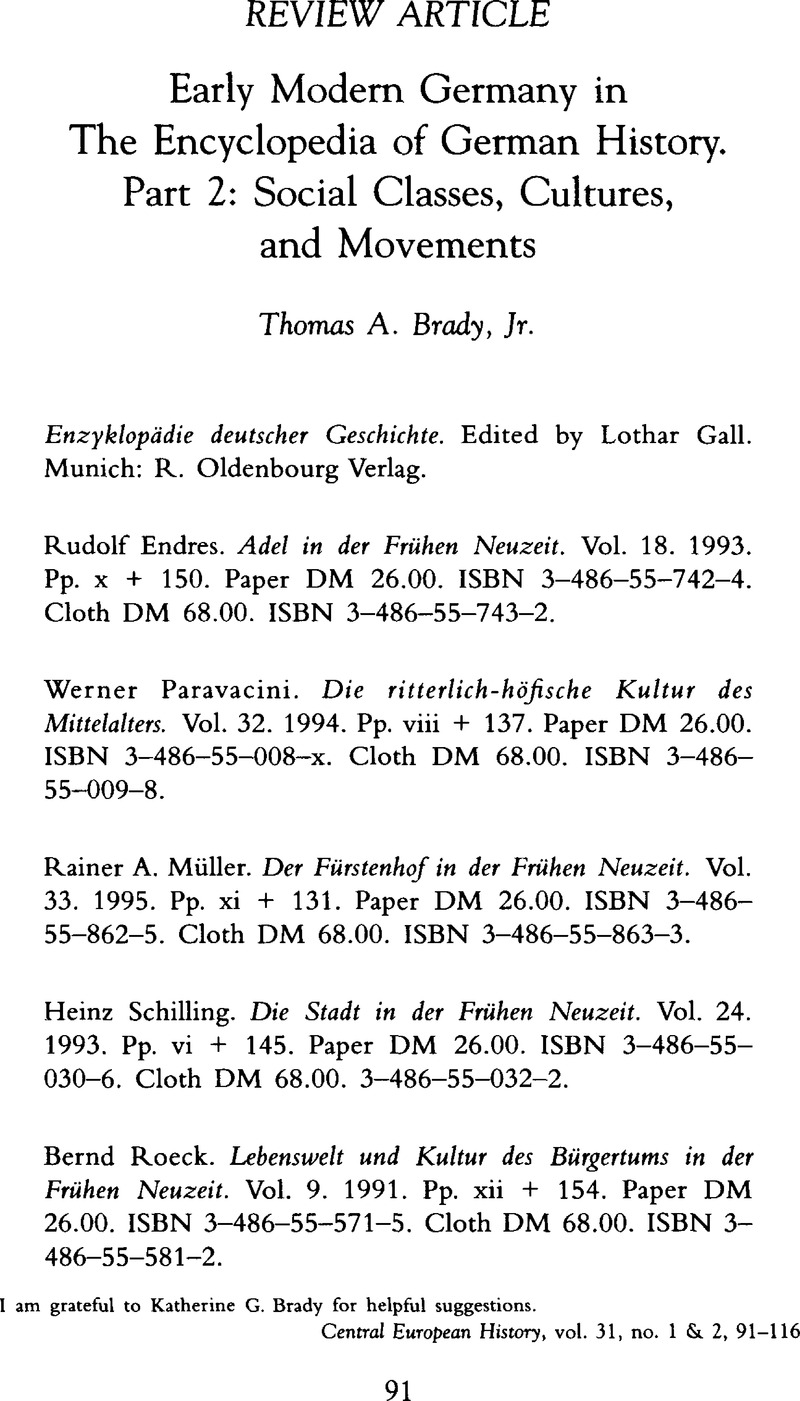No CrossRef data available.
Article contents
Early Modern Germany in The Encyclopedia of German History. Part 2: Social Classes, Cultures, and Movements
Published online by Cambridge University Press: 16 December 2008
Abstract

- Type
- Review Article
- Information
- Copyright
- Copyright © Conference Group for Central European History of the American Historical Association 1998
References
1. Endres, 14.Google Scholar
2. Ibid., 21.
3. Ibid., 27.
4. Ibid., 41.
5. Ibid., 81.
6. Paravicini, 1.Google Scholar
7. Ibid., 45–51.
8. Ibid., 65.
9. This codex, now in Paris, was formerly in Heidelberg, whence its common name, the “Heidelberger Liederhandschrift.”Google Scholar
10. Müller, xi.Google Scholar
11. Ibid., 1.
12. Ibid., 4.
13. Ibid., 88. Of monographic studies he can recommend only Karin Plodeck's on Brandenburg-Ansbach (1971/1972), Gerda Zimmermann's on Würzburg (1976), and Hans-Christoph Ehalt's on Vienna (1981).
14. A volume is planned on The Medieval City by Franz Irsigler.Google Scholar
15. Schilling, ix–x.Google Scholar
16. Schilling here presents, of course, the traditional wisdom about the Dutch and the Hanseatic trade, whereas Franz Mathis (see Part I) argues on good grounds, that Dutch competition did not significantly harm Hanseatic trade.Google Scholar
17. Ibid., 51.
18. Ibid., 58–59, quoting Vries, Jan de, European Urbanization, 1500–1800 (Cambridge, Mass., 1984), 11–13.Google Scholar
19. Schilling, 72, quoting Gerteis, Kurt, Die deutschen Städte in der frühen Neuzeit: Zur Vorgeschichte der bürgerlichen Welt (Darmstadt, 1986), 178.Google Scholar
20. Blickle's volume of the Encyclopedia is reviewed below.Google Scholar
21. Roeck, 1.Google Scholar
22. Ibid., 3. Lebensform is a term he takes from Arno Borst.
23. Ibid., 71.
24. Largely under the influence of Jürgen Kuczynski.Google Scholar
25. Roeck, 81.Google Scholar
26. The most important work, Wunder, Heide, “Er ist die Sonn', sie ist der Mond”: Frauen in der Frühen Neuzeit (Munich, 1992), appeared a year later than Roeck's volume.Google Scholar
27. Hippel, 1.Google Scholar
28. Ibid., 2.
29. Ibid. He speaks of this scope as “too encyclopedic,” whatever that may mean.
30. Ibid., 12.
31. The quoted phrase comes from Hans-Ulrich Wehler, as quoted by Hippel, 17. This view has been overturned, at least for rural Württemberg, by the works of David W. Sabean, which Hippel, oddly enough, does not cite.Google Scholar
32. Hippel, 61.Google Scholar
33. Blickle, 5.Google Scholar
34. Ibid., 49.
35. Ibid., 53.
36. Ibid., 73.
37. Ibid., 86.
38. Goertz, 3.Google Scholar
39. Ibid., 4.
40. Notably by Stayer, James M., “Radical Reformation,” in Handbook of European History, 1400–1600: Late Middle Ages, Renaissance, and Reformation, ed. Brady, Thomas A. Jr, Oberman, Heiko A., and Tracy, James D., 2 vols. (Leiden, 1994–1995), 2:249–82; and see also, Peter Blickle, “Popular Reformation,” in the same volume, 161–92.Google Scholar
41. Goertz, 42.Google Scholar
42. Ibid., 110.
43. Ibid., 87.




